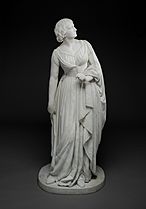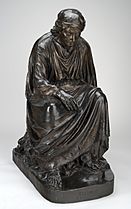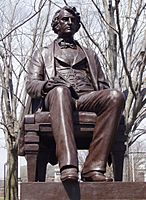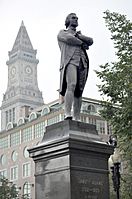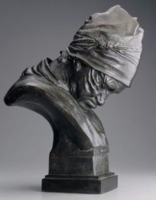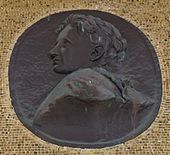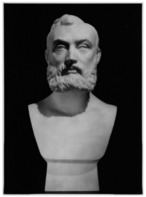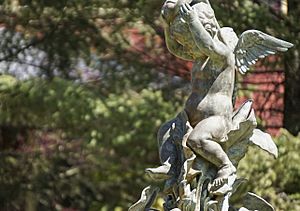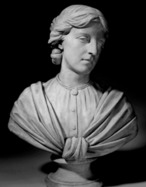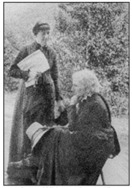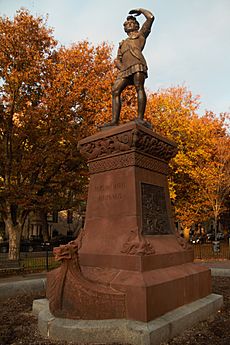Anne Whitney facts for kids
Quick facts for kids
Anne Whitney
|
|
|---|---|
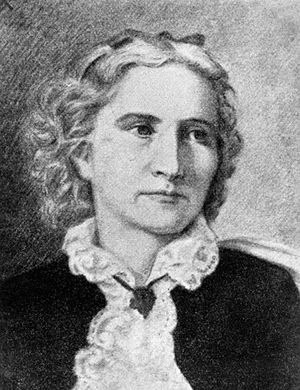
Drawing of Whitney
|
|
| Born | September 2, 1821 |
| Died | January 23, 1915 (aged 93) |
| Resting place | Mount Auburn Cemetery |
| Nationality | American |
| Known for | Sculptor, poet |
Anne Whitney (born September 2, 1821 – died January 23, 1915) was an American artist. She was known for her sculptures and poetry.
Anne Whitney created sculptures of important people. These included full-body statues and busts (head and shoulders). Her art is now in major museums across the United States. She was chosen for important projects, like making monuments. For example, she made two statues of Samuel Adams. One is in Washington, D.C. and the other is in Boston. She also created two statues of Leif Erikson.
Whitney used her art to share her ideas. She believed strongly in ending slavery (abolitionism) and supporting women's rights. Many of her sculptures show famous historical figures. These include people like Harriet Beecher Stowe. She also sculpted women who broke new ground. These were women who fought for voting rights (suffragists). They were also professional artists or held jobs that were unusual for women back then. An example is Alice Freeman Palmer, a famous economist and president of Wellesley College. Anne Whitney lived an independent and unusual life for her time. She had a lifelong close friendship with fellow artist Abby Adeline Manning. They lived and traveled to Europe together.
Contents
Early Life and Education
Anne Whitney was born in Watertown, Massachusetts. Her birthday was September 2, 1821. She was the youngest of seven children. Her parents were Nathaniel Ruggles Whitney, Jr. and Sally Stone Whitney. Both of her parents came from early settlers of Watertown.
Her family were Unitarians. They believed in equal rights for everyone. They were strong supporters of ending slavery. They also fought for women's rights and better education for all.
Anne Whitney mostly learned from private teachers. She also spent one year at a private school in Bucksport, Maine. This year helped her become a teacher herself. From a young age, Anne loved writing poetry. She also became very interested in sculpture.
Becoming an Artist
Starting Her Career
From 1847 to 1849, Anne Whitney ran a small private school. It was in Salem, Massachusetts. After that, she traveled by ship to New Orleans. She visited cousins there from December 1850 to May 1851.
Around 1855, she started making portrait busts of her family. At that time, women had few chances to study art. For example, women could not take classes to draw from live models. Whitney moved to New York City to study anatomy. She studied at a Brooklyn hospital in 1859 and 1860. Then, she studied drawing and modeling in Philadelphia. This was at the Pennsylvania Academy of the Fine Arts.
Anne Whitney was a pioneer of the "New Woman" movement. This movement encouraged women to be independent. Instead of just writing poetry, she chose sculpture. She felt art could better show her strong beliefs about social issues.
In 1859, she made a sculpture called Laura Brown. It was a bust of a young girl. This work was shown in New York. It is now at the Smithsonian American Art Museum. Also in 1859, she published a book of her poems. These poems had appeared in magazines like Atlantic Monthly. People praised her poetry. They said her words were "clean, distinct as if cut in stone."
Art with a Message
In 1860, Anne Whitney opened her own art studio in Watertown. Two years later, she rented a studio in Boston. She studied with artist and doctor William Rimmer. He helped her improve her full-length sculptures. She created a life-size sculpture of Lady Godiva. During the American Civil War, she made a large sculpture called Africa. Both of these artworks showed her political views. Africa represented a whole race breaking free from slavery. Lady Godiva showed a hero helping poor people. These sculptures were displayed in Boston and New York in 1864 and 1865. Lady Godiva is now at the Dallas Museum of Art.
Whitney moved to Rome, Italy, in 1867. She worked there and took trips around Europe. She went to Munich twice to study more. She learned how to work with bronze. Her art from this time includes Chaldean Shepherd and Lotus Eater. In Rome, she joined a group of American women sculptors. She also met other American artists in Italy. These included Edmonia Lewis and Harriet Hosmer.
In 1869, she created a bronze sculpture called Roma. It showed an old beggar woman. This sculpture represented the difficulties people faced in Italy. The country was trying to unite, causing problems between the government and the church. Roma was shown in Philadelphia, Boston, and London. She visited the United States in 1870. Then she returned to Rome for a year. In 1871, she moved back to the United States. She displayed her sculpture of Haitian leader Toussaint Louverture in Boston. In 1872, she opened a studio in Boston.
Famous Monuments
In 1875, Anne Whitney entered a sculpture competition. She submitted a model for a statue of Charles Sumner. He was a senator and an abolitionist. Whitney knew Sumner through her brother. Her model showed Sumner sitting in a chair. She won the contest and the prize money. But then the judges found out she was a woman. They thought it was not proper for a woman to sculpt a man's legs. So, they rejected her work. They chose another artist's sculpture instead. Whitney was disappointed, but she said, "Bury your grievance; it will take more than the Boston Art committee to quench me."
She showed her Sumner model at a big exhibition in 1876. People were surprised by the judges' decision. A newspaper joked about the idea of a woman sculpting a man's legs. But they also praised her work.
One of her most famous public works is the statue of Samuel Adams. It was made in 1876. This statue is in the National Statuary Hall Collection in the United States Capitol in Washington, D.C. Whitney went to Italy in 1875 to get the marble for this sculpture. She also studied French sculpture techniques. This influenced her work Le Modèle, which looked very realistic. A copy of the Samuel Adams statue was made in bronze and granite in 1880. It stands in Faneuil Hall Plaza in Boston. Samuel Adams gave speeches there about British rule and taxes.
Another important work is the statue of Leif Erikson in Boston. It was completed in 1887. She worked with Frederick Law Olmsted on where to place the monument. Another version of the Leif Erikson statue is in Juneau Park in Milwaukee, Wisconsin.
Sculpting Famous Faces
From about 1876 to 1896, Whitney created many portrait sculptures. These were of important people. William Lloyd Garrison, a famous abolitionist, said Whitney's sculpture of him was the best likeness. It is in Boston. She also sculpted Alice Freeman Palmer, the president of Wellesley College. Other subjects included economist Harriet Martineau and suffragists Frances Willard and her cousin Lucy Stone. The sculpture of Lucy Stone is in the Boston Public Library. She also sculpted Mary Tileston Hemenway, a well-known helper of others. Her sculpture of Harriet Beecher Stowe (1892) is at the Mark Twain House. A bust of Stowe is also in Hartford, Connecticut. A medallion of Jennie McGraw Fiske is at Cornell University.
She also made statues and busts of other famous people. These included Edward Charles Pickering and James Walker, who were presidents of Harvard University. These busts are at the Harvard Art Museums. She also sculpted the poet John Keats. Other works are in collections at Amherst College.
Even though she was still healthy, her career slowed down in the 1890s. But she did create a larger version of her Roma sculpture. It was for the World's Columbian Exposition in Chicago in 1893.
For the same exhibition, she also made a fountain called Child with Calla Lily Leaves. It was made of bronze. It had a winged cherub and was decorated with leaves and vines. This style was called Art Nouveau. The fountain was displayed in the Woman's Building at the Exposition. A copy of this fountain is in West Newton, Massachusetts. It was made to honor Anne Whitney's close friend, Catherine Porter Lambert. Her last major artwork was the Charles Sumner sculpture from 1875. It was finished in 1902 and is now in Harvard Square.
Personal Life and Beliefs
Throughout her life, Anne Whitney supported many causes. She cared about protecting forests. She also fought for women's rights. She wanted to end slavery and create equal education for African Americans. Whitney was a very independent person. She lived on her own and even cut her hair short. This was unusual and sometimes bothered her neighbors. She wrote in a poem, "You are welcome, world, to criticize, carp and croak yourself hoarse if you will."
She was active in groups of artists, writers, and political thinkers. She supported other artists and entertained people like Harriet Hosmer at her home. Writer Annie Adams Fields described her as a "noble, simple, strong living woman."
In 1876, she bought a house in Boston. It was at 92 Mt. Vernon Street. She set up her art studio on the top floor. This house is now part of the Boston Women's Heritage Trail. Six years later, she bought a farm in Shelburne, New Hampshire. It had beautiful views of mountains like Mount Washington. She lived at her Boston home until 1893. Then she moved to a hotel nearby. She lived and shared her life with Abby Adeline Manning (1836–1906). Manning dedicated her life to Whitney. They lived abroad together in the 1860s and 1870s. Their close friendship was known as a "Boston marriage" at the time. This term described long-term close relationships between educated women.
Anne Whitney died on January 23, 1915, in Boston, Massachusetts. She was buried in Cambridge at Mount Auburn Cemetery. Abby Adeline Manning is also buried there.
Legacy and Impact
Anne Whitney created important monuments for public places. These include statues of historical figures like Samuel Adams, Charles Sumner, and Leif Erikson. Even though her works are well-known, many people do not know that she was the artist. However, her sculptures are in many museums and collections. The Davis Museum at Wellesley College has seven of her works. These include Roma, Harriet Martineau, and Abby Adeline Manning. Her portrait of Abby Adeline Manning is also at the Peabody Essex Museum.
Whitney also posed for another artist, Cyrus Edwin Dallin. She was the model for his sculpture of Anne Hutchinson. This statue is on the grounds of the Massachusetts State House.
Whitney is also remembered for her role in artist communities in Europe. Women artists could get better education and see original artworks there. This was often not possible for women in the United States at that time. Whitney herself said of Rome, "It is certain that there is not another city on this earth which gives so much (to me) for so little." Her letters from that time show how important her time in Europe was for her art.
The Anne Whitney Archive at Wellesley College has over 4,000 letters, photos, and other documents. These include more than 400 letters she sent to her family. They tell about her life and travels in Europe.
See also
 In Spanish: Anne Whitney para niños
In Spanish: Anne Whitney para niños


